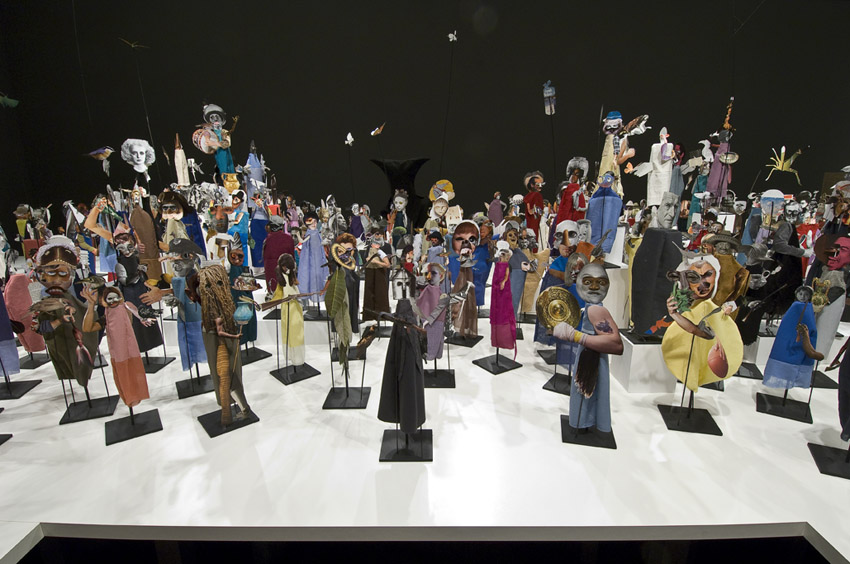Exhibition Review: Geoffrey Farmer The Surgeon and the Photographer
Emily Carr 1992 graduate, Geoffrey Farmer exhibited The Surgeon and the Photographer at Catriona Jeffries Art Gallery from January 29th to March 6th, 2010. The show consisted of an army of cut-and-paste figures also known as The Last Two Million Years. There was also 2 filmic pieces that had to do with similar content, one being a computer controlled montage which used images from Life Magazine.
The title references Walter Benjamin’s essay The Work of Art in the Age of Mechanical Reproduction (1935). The two paragraphs from that text involve a comparison of a painter and a cameraman within a corresponding analogy of a magician and a surgeon. He tries to point out that a cameraman is closer in proximity to reality than a painter, despite the obvious problem that his reality is always filtered through a machine. With the critique of painting and the promotion of cinematic film aside, Benjamin’s states that “…the cameraman consists of multiple fragments which are assembled under a new law.” (Benjamin) This “new law” could refer to the specific methodology of creating each of the 365 pieces in the show and this assemblage will always be somewhat fragmentary in nature. The exhibition title calls up images of the collage process, where material is cut with precision, much like a surgery, and that material was offered up by a camera as it is mostly photographic.
But each piece also uses cloth and is put into a 3 dimensional arrangement. This is an unconventional outcome for a collage and creates a dialogue between it and another medium, sculpture. The problem of translation makes this relationship especially interesting since the photographic print bits remain 2D within this new 3D art form. Each flimsy seemingly temporary structure, often with its scotch-tape exposed, is put together on black bases with supporting posts which are uniform throughout the show.
With white pedestals at various heights and a non-linear organization of the figures, the show supposedly incorporates the non-hierarchical presentation technique by Aby Warburg's Mnemosyne Atlas. This becomes a way for Farmer to intellectually forfeit the authoritarian role over the installation. Of course, this is assuming we forget the problematic setting of the white cube and that Geoffrey needed to maintain a constant number of pieces to use the framework of a typical calendar year. In the original, Aby Warburg’s own subject position was expressed through his endless work as “…he searches for the proper arrangement of his fragmentary universe.” (Dillon) The comparison offered by the exhibition is not entirely useful as Warburg’s memory map would have been more malleable as he journeys through time and space. One table in the exhibition is in direct contradiction to this idea, where the central group carries long flag-like posts unlike the outer figures on the edges, making it appear aesthetically dictated.
Warburg was also an early researcher of the Native American Hopi, whose Kachina dolls bare a resemblance to these sculptures by Farmer. However, these new dolls do not carry dogmatic symbolic meaning or ceremonial purpose (unless we consider art gallery attendance a purposeful ceremony). Instead they seem to be a chaotic arrangement of a collective memory in limited availability as it’s expressed through printed photographic material.
Bibliography
Benjamin, Walter, "The Work of Art in the Age of Mechanical Reproduction” Illuminations Ed. Hannah Arendt. New York: Schocken Books, 1968. 217-251
Dillon, Brian. “Collected Works: Aby Warburg's Mnemosyne Atlas”. Frieze. Issue 80, January-February 2004

